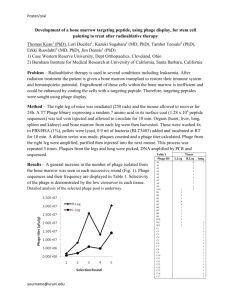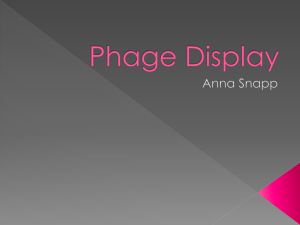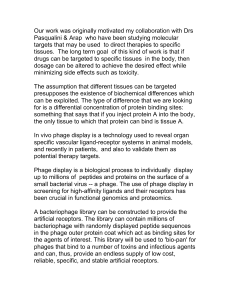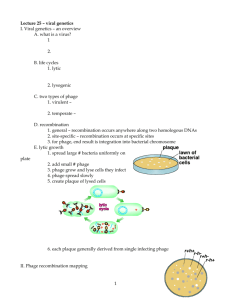see
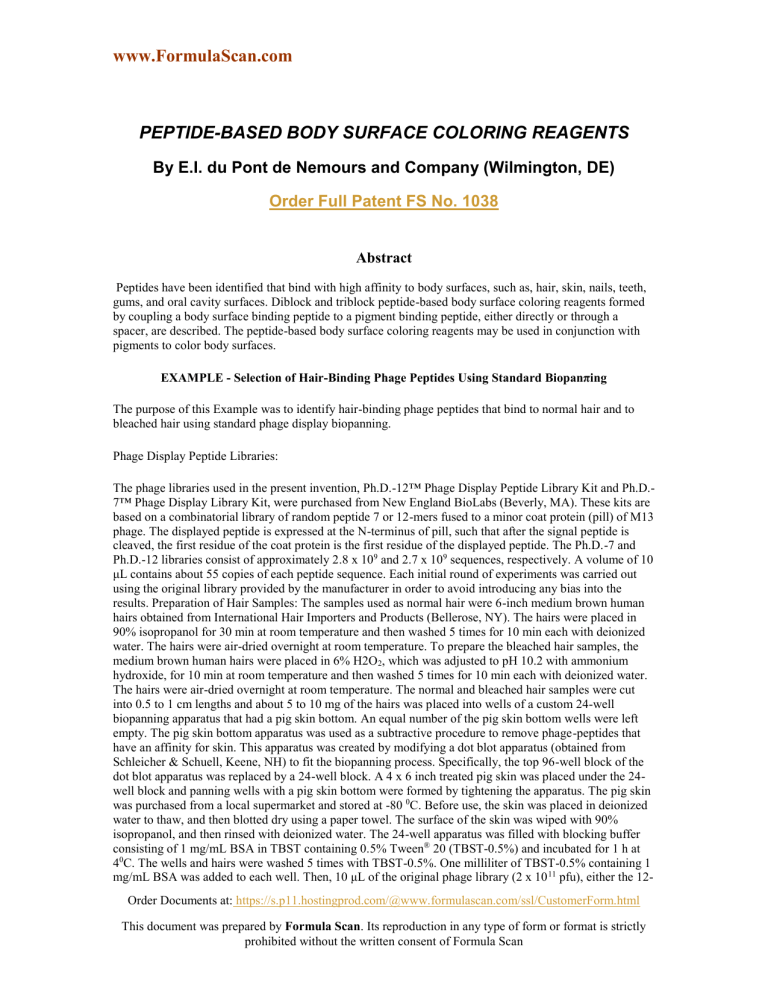
www.FormulaScan.com
PEPTIDE-BASED BODY SURFACE COLORING REAGENTS
By E.I. du Pont de Nemours and Company (Wilmington, DE)
Order Full Patent FS No. 1038
Abstract
Peptides have been identified that bind with high affinity to body surfaces, such as, hair, skin, nails, teeth, gums, and oral cavity surfaces. Diblock and triblock peptide-based body surface coloring reagents formed by coupling a body surface binding peptide to a pigment binding peptide, either directly or through a spacer, are described. The peptide-based body surface coloring reagents may be used in conjunction with pigments to color body surfaces.
EXAMPLE - Selection of Hair-Binding Phage Peptides Using Standard Biopanπing
The purpose of this Example was to identify hair-binding phage peptides that bind to normal hair and to bleached hair using standard phage display biopanning.
Phage Display Peptide Libraries:
The phage libraries used in the present invention, Ph.D.-12™ Phage Display Peptide Library Kit and Ph.D.-
7™ Phage Display Library Kit, were purchased from New England BioLabs (Beverly, MA). These kits are based on a combinatorial library of random peptide 7 or 12-mers fused to a minor coat protein (pill) of M13 phage. The displayed peptide is expressed at the N-terminus of pill, such that after the signal peptide is cleaved, the first residue of the coat protein is the first residue of the displayed peptide. The Ph.D.-7 and
Ph.D.-12 libraries consist of approximately 2.8 x 10 9 and 2.7 x 10 9 sequences, respectively. A volume of 10
μL contains about 55 copies of each peptide sequence. Each initial round of experiments was carried out using the original library provided by the manufacturer in order to avoid introducing any bias into the results. Preparation of Hair Samples: The samples used as normal hair were 6-inch medium brown human hairs obtained from International Hair Importers and Products (Bellerose, NY). The hairs were placed in
90% isopropanol for 30 min at room temperature and then washed 5 times for 10 min each with deionized water. The hairs were air-dried overnight at room temperature. To prepare the bleached hair samples, the medium brown human hairs were placed in 6% H2O
2
, which was adjusted to pH 10.2 with ammonium hydroxide, for 10 min at room temperature and then washed 5 times for 10 min each with deionized water.
The hairs were air-dried overnight at room temperature. The normal and bleached hair samples were cut into 0.5 to 1 cm lengths and about 5 to 10 mg of the hairs was placed into wells of a custom 24-well biopanning apparatus that had a pig skin bottom. An equal number of the pig skin bottom wells were left empty. The pig skin bottom apparatus was used as a subtractive procedure to remove phage-peptides that have an affinity for skin. This apparatus was created by modifying a dot blot apparatus (obtained from
Schleicher & Schuell, Keene, NH) to fit the biopanning process. Specifically, the top 96-well block of the dot blot apparatus was replaced by a 24-well block. A 4 x 6 inch treated pig skin was placed under the 24well block and panning wells with a pig skin bottom were formed by tightening the apparatus. The pig skin was purchased from a local supermarket and stored at -80 0 C. Before use, the skin was placed in deionized water to thaw, and then blotted dry using a paper towel. The surface of the skin was wiped with 90% isopropanol, and then rinsed with deionized water. The 24-well apparatus was filled with blocking buffer consisting of 1 mg/mL BSA in TBST containing 0.5% Tween
®
20 (TBST-0.5%) and incubated for 1 h at
4 0 C. The wells and hairs were washed 5 times with TBST-0.5%. One milliliter of TBST-0.5% containing 1 mg/mL BSA was added to each well. Then, 10 μL of the original phage library (2 x 10 11 pfu), either the 12-
Order Documents at: https://s.p11.hostingprod.com/@www.formulascan.com/ssl/CustomerForm.html
This document was prepared by Formula Scan . Its reproduction in any type of form or format is strictly prohibited without the written consent of Formula Scan
www.FormulaScan.com
mer or 7-mer library, was added to the pig skin bottom wells that did not contain a hair sample and the phage library was incubated for 15 min at room temperature. The unbound phages were then transferred to pig skin bottom wells containing the hair samples and were incubated for 15 min at room temperature. The hair samples and the wells were washed 10 times with TBST-0.5%. The hairs were then transferred to clean, plastic bottom wells of a 24-well plate and 1 ml_ of a non-specific elution buffer consisting of 1 mg/mL BSA in 0.2 M glycine-HCI, pH 2.2, was added to each well and incubated for 10 min to elute the bound phages. Then, 160 μL of neutralization buffer consisting of 1 M Tris-HCI, pH 9.2, was added to each well. The eluted phages from each well were transferred to a new tube for titering and sequencing.
To titer the bound phages, the eluted phage was diluted with SM buffer (100 mM NaCI, 12.3 mM MgSO
4
-7
H
2
O, 50 mM Tris-HCI, pH 7.5, and 0.01 wt/vol % gelatin) to prepare 10-fold serial dilutions of 10 1 to 10
A 10 μL aliquot of each dilution was incubated with 200 μL of mid-log phase E. cofi ER2738 (New
4 .
England BioLabs), grown in LB medium for 20 min and then mixed with 3 mL of agarose top (LB medium with 5 mM MgCl
2
, and 0.7% agarose) at 45 0 C. This mixture was spread onto a S- Gal™/LB agar plate
(Sigma Chemical Co.) and incubated overnight at 37 0 C. The S-Gal™/LB agar blend contained 5 g of tryptone, 2.5 g of yeast extract, 5 g of sodium chloride, 6 g of agar, 150 mg of 3,4- cyclohexenoesculetin-β-
D-galactopyranoside (S-Gal™), 250 mg of ferric ammonium citrate and 15 mg of isopropyl β-Dthiogalactoside (iPTG) in 500 mL of distilled water. The plates were prepared by autoclaving the S- Gal™
/LB for 15 to 20 min at 121-124 0 C. The single black plaques were randomly picked for DNA isolation and sequence analysis.
The remaining eluted phages were amplified by incubating with diluted E.coli ER2738, from an overnight culture diluted 1 :100 in LB medium, at 37 0 C for 4.5 h. After this time, the cell culture was centrifuged for
30 s and the upper 80% of the supernatant was transferred to a fresh tube, 1/6 volume of PEG/NaCI (20% polyethylene glyco-800, 2.5 M sodium chloride) was added, and the phage was allowed to precipitate overnight at 4 0 C. The precipitate was collected by centrifugation at 10,000 x g at 4 0 C and the resulting pellet was resuspended in 1 mL of TBS. This was the first round of amplified stock. The amplified first round phage stock was then titered according to the same method as described above. For the next round of biopanning, more than 2 x10 11 pfu of phage stock from the first round was used. The biopanning process was repeated for 3 to 6 rounds depending on the experiments.
The single plaque lysates were prepared following the manufacture's instructions (New England Biolabs) and the single stranded phage genomic DNA was purified using the QIAprep Spin M13 Kit (Qiagen,
Valencia, CA) and sequenced at the DuPont Sequencing Facility using -96 gill sequencing primer (5'-
CCCTCATAGTTAGCGTAACG-3 I ), given as SEQ ID NO:62. The displayed peptide is located immediately after the signal peptide of gene III.
The amino acid sequences of the eluted normal hair-binding phage peptides from the 12-mer library isolated from the fifth round of biopanning are given in Table 1. The amino acid sequences of the eluted bleached hair-binding phage peptides from the 12-mer library isolated from the fifth round of biopanning are given in Table 2. Repeated amino acid sequences of the eluted normal hair-binding phage peptides from the 7- mer library from 95 randomly selected clones, isolated from the third round of biopanning, are given in Table 3.
Order Documents at: https://s.p11.hostingprod.com/@www.formulascan.com/ssl/CustomerForm.html
This document was prepared by Formula Scan . Its reproduction in any type of form or format is strictly prohibited without the written consent of Formula Scan
www.FormulaScan.com
Order Documents at: https://s.p11.hostingprod.com/@www.formulascan.com/ssl/CustomerForm.html
This document was prepared by Formula Scan . Its reproduction in any type of form or format is strictly prohibited without the written consent of Formula Scan
www.FormulaScan.com
Note Raw Material Suppliers: Please subscribe to our service if you want Formula Scan to provide direct links to your ingredient’s web site for further description, information, specifications and contact information.
Order Documents at: https://s.p11.hostingprod.com/@www.formulascan.com/ssl/CustomerForm.html
This document was prepared by Formula Scan . Its reproduction in any type of form or format is strictly prohibited without the written consent of Formula Scan
